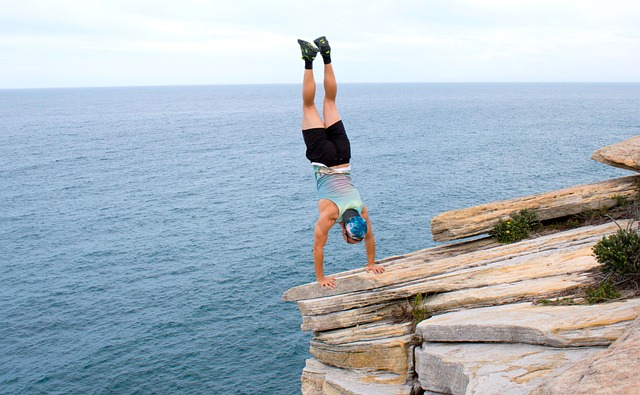Handstand balance is the ability to maintain stability and control while performing a handstand. It requires a combination of strength, flexibility, and proper technique.
Handstand balance is an important skill in gymnastics, as well as other sports such as acrobatics, parkour, and calisthenics. It is a foundational skill that is used in many other acrobatic and gymnastic movements.
The purpose of this article is to provide tips and exercises to help improve handstand balance. The focus will be on warm-up and stretching, strengthening exercises, and specific practice techniques to help you achieve better handstand balance. Whether you are a beginner or an experienced gymnast, these tips can help you achieve your handstand balance goals.
Understanding the Handstand
The anatomy of the handstand position involves proper alignment of the hands, shoulders, and legs. It is important to have strong, stable shoulders and a strong core to maintain balance while performing a handstand.
The physics behind handstand balance involves the principles of leverage and center of gravity. In order to maintain balance, the center of gravity must remain over the hands. This requires proper alignment, body control, and coordination.
Common misconceptions about handstands include the idea that they are purely a test of strength, and that they can only be performed by those with naturally flexible bodies. In reality, handstand balance is a combination of strength, flexibility, and proper technique, and can be improved through consistent practice and proper training.
Warm-Up and Stretching
Warming up before handstand practice is crucial in preventing injury and improving performance. It prepares the body for the physical demands of handstands and increases blood flow to the muscles.
Stretching exercises are important for improving flexibility and range of motion, which are crucial for handstand balance. Stretches for the shoulders, wrists, and hamstrings are especially important. Examples of such stretches include wrist stretches, shoulder stretches, and hamstring stretches.
Incorporating warm-up and stretching into your handstand practice routine is easy. Begin by performing 5-10 minutes of light cardio to increase your heart rate and warm up your muscles. Follow that with a series of stretching exercises, focusing on the areas of your body that will be most active during handstands. This can be done before each handstand practice session, and should take around 10-15 minutes.
Strengthening Exercises
Strengthening exercises are crucial for improving handstand balance, as they help to build the necessary muscle strength and control needed to maintain stability in the handstand position.
Upper body strength exercises, such as push-ups, planks, and dips, can help to build the strength in your arms, shoulders, and core needed for handstands.
Core and shoulder stability exercises, such as bird-dogs, Russian twists, and back bridges, can also help to improve handstand balance by building the stability and control needed to maintain the proper handstand alignment.
Incorporating strength exercises into your handstand practice routine can be as simple as adding in a few sets of push-ups, planks, and other exercises before or after your handstand practice. It’s important to start with lower-impact exercises and gradually progress to more challenging ones, as well as to listen to your body and avoid overtraining. Incorporating strength training 2-3 times per week can help you see significant improvements in your handstand balance over time.
Practice Techniques
Wall-assisted handstands are a great place to start for beginners, as they provide support and stability while building confidence and strength. To perform a wall-assisted handstand, simply place your hands on the ground a few inches away from a wall and kick up into a handstand, using the wall for support as needed.
Free-standing handstands are the ultimate goal for many gymnasts and acrobats, and they require a great deal of strength, control, and balance. To perform a free-standing handstand, simply kick up into a handstand from a standing position, using your arms, core, and legs to maintain balance.
Handstand holds and balance drills are important for building strength and improving balance. This can be as simple as holding a handstand for a few seconds, or practicing handstand balance drills such as handstand walks or handstand kicks.
The progression from wall-assisted to free-standing handstands requires patience and consistency. Start by gradually moving your hands further away from the wall and decreasing your dependence on it for support. As you build confidence and strength, you will be able to perform longer and more controlled handstands.
Tips for improving handstand balance and technique include focusing on proper alignment, engaging your core, and practicing regularly. It’s also important to work on your flexibility, strength, and control, as these factors all play a role in achieving better handstand balance. With consistent practice and dedication, you can achieve your handstand balance goals.
Conclusion
In this article, we have covered the importance of handstand balance in gymnastics and other sports, and provided a comprehensive guide on how to improve it. We discussed the anatomy of the handstand position, the physics behind handstand balance, and common misconceptions. We also covered the importance of warm-up and stretching, as well as strengthening exercises, practice techniques, and tips for improvement.
Handstand balance is a crucial skill for gymnasts and acrobats, as well as for anyone looking to improve their overall physical fitness and coordination. With the right training and dedication, anyone can improve their handstand balance and achieve their goals.
We encourage you to continue practicing and improving your handstand balance. Remember to warm up properly, stretch regularly, build strength, and work on your technique. With persistence and hard work, you can achieve great things and become a master of handstand balance.

